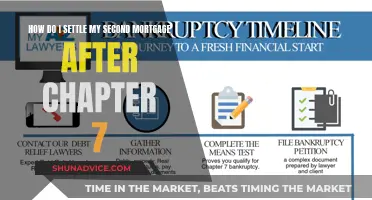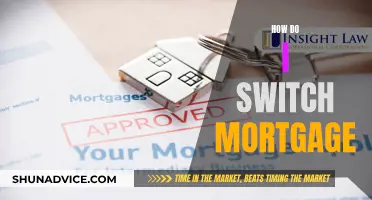
Private mortgage insurance (PMI) is an additional cost that can add hundreds of dollars to your monthly mortgage payments. It is usually required when the down payment on a home is 20% or less of the property's value. However, there are ways to remove PMI from your mortgage. The general rule is that you can request PMI be removed once you have reached 20% equity in your home. This can be achieved by making extra payments towards your principal balance. It's important to note that the rules for removing PMI may vary depending on the type of property and the lender, so it's always a good idea to check with your lender or servicer about your specific options.
| Characteristics | Values |
|---|---|
| Removal of PMI | You can request to remove PMI once you have paid down your mortgage to a specified point. |
| You can ask to cancel PMI ahead of the scheduled date if you have made additional payments that reduce the principal balance of your mortgage to 80% of the original value of your home. | |
| You can only remove LPMI by refinancing. | |
| You can make extra payments toward your principal balance to meet the requirements to remove PMI faster. | |
| You can build up equity in your home to at least 20%. | |
| You can request removal based on an increase in market value or home improvements pushing up your home value. | |
| If you've owned the home for at least five years and your loan balance is no more than 80% of the new valuation, you can ask for PMI cancellation. | |
| If you've owned the home for at least two years, your remaining mortgage balance must be no greater than 75%. | |
| You can request to have PMI cancelled if there has not been a property value decline based on the actual sales price or original appraised value. | |
| You can request to have PMI cancelled if there are no subordinate liens, such as a second mortgage. | |
| You can request to have PMI cancelled if your loan has not been more than 60+ days past due in mortgage payments within the last two years or 30+ days past due within the last year. |
What You'll Learn

You can request to cancel PMI when you reach 20% equity
Private mortgage insurance (PMI) is a type of insurance that protects the lender in the event that you default on your mortgage. It is required when the down payment on a home is less than 20%. The cost of PMI depends on several factors, including the total loan amount, credit score, and loan type.
To remove PMI, a written request is typically required by federal law. You can contact your servicer or lender to initiate the process. They may provide specific forms to fill out or outline certain instructions to follow. Additionally, a home valuation may be necessary to ensure that the home value has not declined below the original value. This may involve an appraisal or alternative methods.
It's worth mentioning that PMI cancellation guidelines can vary. Loan investors like Fannie Mae and Freddie Mac may have their own guidelines, but they cannot be less favorable to the borrower than the standard rules. Additionally, mortgages obtained through the Federal Housing Administration (FHA) or Department of Veterans Affairs (VA) have distinct requirements for PMI removal.
Removing Your Name from a Joint Mortgage: A Step-by-Step Guide
You may want to see also

Lenders must automatically cancel PMI when the LTV reaches 78%
Private mortgage insurance (PMI) is a type of insurance that compensates the lender in the event that the borrower defaults on their loan. It is required for borrowers who take out a conventional loan with a down payment of less than 20% of the purchase price. The cost of PMI is usually added to the borrower's monthly mortgage payment.
Lenders must automatically cancel PMI when the loan-to-value (LTV) ratio reaches 78%. The LTV ratio is used to assess the level of risk associated with a loan. It is calculated by dividing the loan amount by the appraised value of the property. A higher LTV ratio indicates a higher level of risk for the lender, as there is a greater chance of the loan going into default. Therefore, loans with high LTV ratios often have higher interest rates and may require the borrower to purchase PMI.
In the context of PMI cancellation, when the LTV ratio reaches 78%, it means that the borrower has built up enough equity in their home to no longer be considered a high-risk borrower. At this point, the lender is required to cancel the PMI, reducing the borrower's monthly costs.
It is important to note that the borrower must be current on their monthly payments for PMI cancellation to occur. Additionally, the borrower may be required to provide evidence, such as an appraisal, to show that the value of their property has not declined.
Reaffirming Your Mortgage After Chapter 7: What You Need to Know
You may want to see also

PMI cancellation rules vary for multiunit properties or rentals
Private mortgage insurance (PMI) provides a payment for part of the outstanding loan amount if a borrower defaults on their loan. It is not a bad idea to save as much as possible for a down payment, but this is not feasible for many buyers. PMI allows you to make a smaller down payment on a home, which can be beneficial in a pricey housing market.
PMI cancellation rules vary for multi-unit properties or rentals. For instance, if your loan is serviced by Fannie Mae, the mortgage insurance cancels automatically halfway through the loan term for multi-unit properties or rentals. However, if your loan is owned by Freddie Mac, there is no automatic cancellation of mortgage insurance. If you are requesting removal based on the original value of the home, you need at least 30% equity.
The general rule is that you can request PMI be removed from your loan once you reach 20% equity. This applies to BPMI, whereas LPMI can only be removed by refinancing. Under federal law, this request must be made in writing. Your servicer will give you instructions on how to do this. You can also request removal based on an increase in market value or home improvements that have increased your home's value.
To get rid of PMI, you will need to contact your servicer. They will send someone to appraise your home and ensure that its value has not declined. This usually costs a few hundred dollars but can depend on location and the characteristics of your property. Some lenders may be willing to accept a broker price opinion, which is often cheaper.
Removing Your Ex-Husband from Your Mortgage: A Step-by-Step Guide
You may want to see also

You can make extra payments to meet the requirements to remove PMI faster
Private mortgage insurance (PMI) is a surcharge that increases your monthly mortgage payment. It is usually required if your down payment is less than 20% of the home's cost. The good news is that you don't have to pay PMI for the entire duration of your mortgage. You can make extra payments towards your principal balance to meet the requirements to remove PMI faster. Here's how:
First, check with your lender to see if making extra payments is allowed on your loan. Not all loans may permit this option. Once confirmed, you can start making extra payments towards your principal balance. This can be done in several ways, such as biweekly payments, an additional payment each year, or even a lump sum payment at any time. Just be sure to communicate with your lender or servicer to ensure that these extra payments go towards the loan's principal and not towards your next payment or interest.
Making extra payments will help you build equity in your home faster. The goal is to reach at least 20% equity. Once you've achieved this, you can contact your servicer and make a request to remove PMI. Legally, this request must be made in writing, and your servicer will provide you with specific instructions on how to proceed. Keep in mind that your servicer may require a home valuation or appraisal to confirm that the home value meets expectations and hasn't declined below the original value.
By making extra payments, you can speed up the process of removing PMI from your mortgage. This will not only reduce your monthly costs but also help you build more equity in your home sooner. Remember to stay current on your monthly payments, as falling behind could impact the removal of PMI.
Porting Your Mortgage: What You Need to Know
You may want to see also

LPMI can only be removed by refinancing
LPMI, or Lender-Paid Mortgage Insurance, is a type of mortgage insurance where the lender pays the insurance premiums. In exchange, the lender will usually give you a higher interest rate than they would if you paid the insurance as a monthly fee or didn't have PMI. The benefit of LPMI is that it allows you to make a smaller down payment on a home, which can be advantageous in a pricey housing market. However, the cost of LPMI is built into your interest rate, and unlike traditional PMI, it does not come off once you reach 20% equity. As a result, the only way to stop paying for LPMI is by refinancing to a new loan.
When refinancing to remove LPMI, it's important to consider the rate and payment compared to what is available on the current market, as well as the closing costs. Refinancing may result in a lower mortgage rate than you had with LPMI, but it might not be enough to offset the sharp rise in mortgage and refinance rates since 2022. Additionally, if you itemize deductions on your tax return, you can deduct the cost of the increased interest charged for LPMI through the mortgage interest deduction.
It's worth noting that the requirements for removing PMI can vary depending on the type of property and the lender. For example, the rules for removing PMI from a multi-unit or investment property may be different from those for a single-unit or vacation home. Additionally, some lenders and servicers may allow the removal of PMI under their own standards, so it's always a good idea to check with your lender or servicer to understand their specific requirements and guidelines.
To remove PMI from your mortgage, you will typically need to reach at least 20% equity in your home. This means that your loan balance should not be more than 80% of the value of your home. You may also need to provide evidence, such as an appraisal, to show that the value of your property has not declined below its original value. Once you meet the required criteria, you can submit a written request to your lender or servicer to cancel the PMI.
Removing a Name from Your Mortgage: What You Need to Know
You may want to see also
Frequently asked questions
You can request to cancel PMI once you have reached 20% equity in your home. You will need to contact your loan servicer and make a written request. You may also need to pay for a home appraisal to verify the new market value.
You can check your remaining loan balance against your estimated home value. If it is less than 80%, you can contact your servicer about removing PMI.
PMI allows you to make a smaller down payment on a home. In a pricey housing market, this means you can buy a home sooner.
The cost of PMI depends on several factors, such as your credit score and loan-to-value (LTV) ratio. PMI can add a couple of hundred dollars to your monthly mortgage payments.
You can make extra payments towards your principal balance to meet the requirements faster. You can also reappraise your home to see if it has gained in market value, which may put your LTV at 78% or lower.







